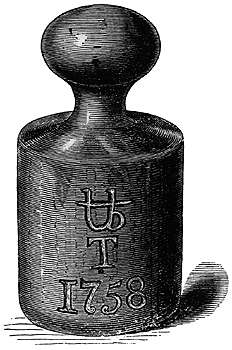Troy weight
System of units of mass used for precious metals
Troy weight is a system of units of mass that originated in the Middle Ages and is primarily used today in the precious metals industry. The system is named after the city of Troyes in France, where it was first used. The troy weight system is distinct from the more common avoirdupois system, which is used for most other goods.
Units of Troy Weight[edit | edit source]
The troy weight system includes several units:
- Troy ounce: The troy ounce is the most commonly used unit in the troy weight system. It is equal to 31.1034768 grams. The troy ounce is used to measure the mass of precious metals such as gold, silver, platinum, and palladium.
- Troy pound: The troy pound consists of 12 troy ounces, which is different from the avoirdupois pound that contains 16 ounces. The troy pound is equal to 373.2417216 grams.
- Pennyweight: The pennyweight is another unit in the troy system, equal to 1/20 of a troy ounce, or 1.55517384 grams. It is often used in the jewelry industry.
History[edit | edit source]
The troy weight system has its origins in the Roman monetary system, which used bronze bars as currency. The system was later adopted by the Medieval European merchants and became standardized in the city of Troyes, a major trading hub. The troy weight system was officially adopted in England in 1527 during the reign of Henry VIII.
Comparison with Avoirdupois[edit | edit source]
The troy weight system differs from the avoirdupois system, which is used for most everyday goods. The avoirdupois pound is heavier than the troy pound, weighing 453.59237 grams compared to the troy pound's 373.2417216 grams. However, the troy ounce is heavier than the avoirdupois ounce, which weighs 28.349523125 grams.
Modern Usage[edit | edit source]
Today, the troy weight system is primarily used in the trading of precious metals. The London Bullion Market and other major exchanges use troy ounces as the standard unit of measure for gold, silver, and other precious metals.
Related pages[edit | edit source]
References[edit | edit source]
Search WikiMD
Ad.Tired of being Overweight? Try W8MD's physician weight loss program.
Semaglutide (Ozempic / Wegovy and Tirzepatide (Mounjaro / Zepbound) available.
Advertise on WikiMD
|
WikiMD's Wellness Encyclopedia |
| Let Food Be Thy Medicine Medicine Thy Food - Hippocrates |
Translate this page: - East Asian
中文,
日本,
한국어,
South Asian
हिन्दी,
தமிழ்,
తెలుగు,
Urdu,
ಕನ್ನಡ,
Southeast Asian
Indonesian,
Vietnamese,
Thai,
မြန်မာဘာသာ,
বাংলা
European
español,
Deutsch,
français,
Greek,
português do Brasil,
polski,
română,
русский,
Nederlands,
norsk,
svenska,
suomi,
Italian
Middle Eastern & African
عربى,
Turkish,
Persian,
Hebrew,
Afrikaans,
isiZulu,
Kiswahili,
Other
Bulgarian,
Hungarian,
Czech,
Swedish,
മലയാളം,
मराठी,
ਪੰਜਾਬੀ,
ગુજરાતી,
Portuguese,
Ukrainian
Medical Disclaimer: WikiMD is not a substitute for professional medical advice. The information on WikiMD is provided as an information resource only, may be incorrect, outdated or misleading, and is not to be used or relied on for any diagnostic or treatment purposes. Please consult your health care provider before making any healthcare decisions or for guidance about a specific medical condition. WikiMD expressly disclaims responsibility, and shall have no liability, for any damages, loss, injury, or liability whatsoever suffered as a result of your reliance on the information contained in this site. By visiting this site you agree to the foregoing terms and conditions, which may from time to time be changed or supplemented by WikiMD. If you do not agree to the foregoing terms and conditions, you should not enter or use this site. See full disclaimer.
Credits:Most images are courtesy of Wikimedia commons, and templates, categories Wikipedia, licensed under CC BY SA or similar.
Contributors: Prab R. Tumpati, MD









